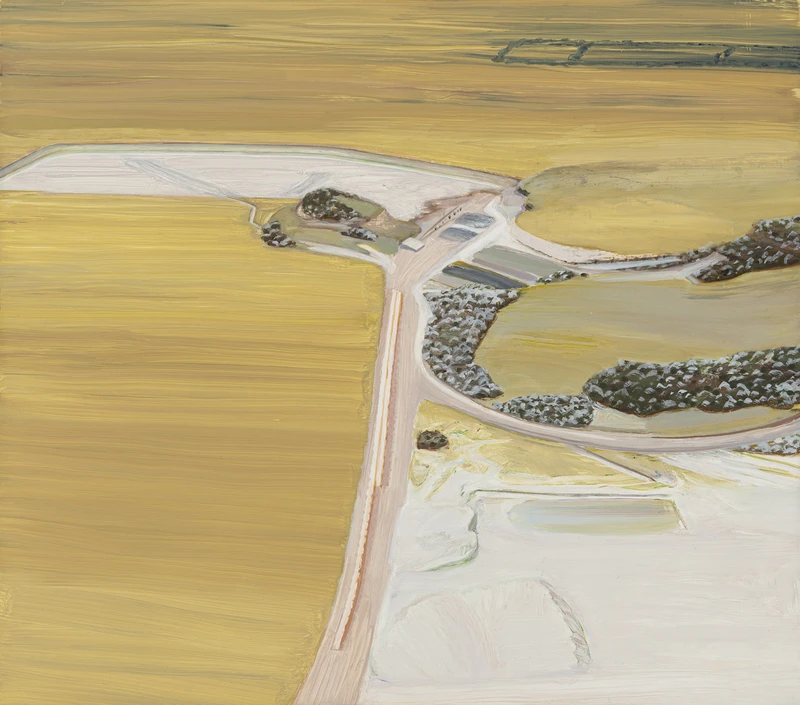Carol Rhodes


b. 1959, United Kingdom
d. 2018
Scottish painter, 1959-2018
Carol Rhodes (b.1959, Edinburgh, Scotland; d.2018, Glasgow, Scotland) created a distinctive mode of landscape painting across her 25-year career, developing a world of semi-fictional locations that are at once familiar and ambiguous. Intimately scaled, densely rendered and typically taking an aerial viewpoint, her works depict uninhabited industrial terrains and ‘edgelands’ – factories, canals, motorways, reservoirs – described by the artist as ‘hidden areas’. Psychologically charged and often muted in colour, Rhodes’s paintings reflect on our experiences of place, the ways in which we perceive, make and adapt our environments.
Though born in Edinburgh, Rhodes was brought up from infancy in India, living just outside Kolkata, until she relocated to the UK in her mid-teens to complete her education. She continued to visit India one or twice a year into her twenties, and her time there would prove deeply influential for her later artistic practice. Returning to West Bengal in 2012–13 to complete a residency, Rhodes noted: ‘My early experience of India (its colours, density of detail), and then the estrangement from it, has informed my work in incalculable ways’.
Further sources fed into Rhodes’s visual language. Aerial photographs, taken herself or found in illustrated books on geography and the environment, were one basis of her compositions. ‘I might use many photographs, combining different parts of them in a drawing’, she explained, ‘establishing the space, scale, colours, viewpoint’. Such preparatory drawings played an important role in this process, allowing Rhodes to create what she called ‘a fictional synthesis’ – a composition that she would then trace directly onto board as a ‘skeleton’ for a painting. Later in her career, Rhodes began to exhibit these drawings as works in their own right.
Rhodes studied at the Glasgow School of Art (1977-82) but, following her graduation, became involved in social activism, organising and participating in feminist, pacifist, gay rights and social justice campaigns. She co-founded the Glasgow Free University and, between 1986 and 1988, was part of a burgeoning group of artists associated with Transmission, the artist-led gallery of which she was a committee member. Rhodes returned to painting in 1990 and was included in such exhibitions as ‘New Art in Scotland’ (1994) at CCA Glasgow. Greater exposure came as a result of her first solo exhibition, in 1998, at Andrew Mummery Gallery, London, at which point works began to enter public collections. In 2007, a retrospective exhibition of Rhodes’s work was presented at the Scottish National Gallery of Modern Art in Edinburgh.
The scenes in Rhodes’s paintings might initially appear emotionally and ideologically detached, perhaps due to their composite nature. She stated that ‘the impetus is partly to create a mood, a temperature, a puzzle’. But whether in impartially illustrating environmental damage caused by industrial ravage, or in other ways registering the process of human circulation and habitation, the artist’s political awareness remained embedded in her work, albeit subtly. Rhodes spoke of being ‘spatially egalitarian […] seeing the landscape top to bottom, not near and far […] giving everything a sort of equal status in the pictures’. For related reasons, she was ‘interested by the backs of buildings and places, not the fronts’, commenting, ‘these things may sound slight in themselves, or “merely” formal, but they’re all part of what makes a painting and gives it meaning and power’.
Alison Jacques Gallery represents Carol Rhodes in partnership with the Carol Rhodes Estate, whose curator Andrew Mummery worked closely with Rhodes for much of her career.